
Introduction, design and display
When Nvidia first showed off its Shield Tablet in 2014, we were a bit unimpressed. After all, Android tablets were coming out in droves and it was rather difficult to stick out when Google’s own Nexus 7 was putting them all to shame. Plus, the original Shield clamshell was more unique, even if it wasn’t the best-looking device.
The landscape looks a lot different now. Google itself has moved on to making larger tablets to compete with Apple’s iPad, and most of the market has generally dialed back its focus. So, when Nvidia announced the Shield Tablet K1 in late 2015, I was actually pretty interested.
Here, we have an 8-inch tablet with a respectable screen resolution of 1,920 x 1,200. It fits nicely onto my palm and rocks an understated look that completely hides away its DNA, which is thoroughly steeped in green gaming goodness.
The Shield Tablet K1 exists in a world without the Nexus 7 to hold it back, and based on looks alone, this might as well be the next Nexus tablet. It rocks a simplistic look and packs in nearly every feature that you might want. Dual speakers, microSD, good battery life and fast specs are all here. Plus, you might even think you’re using a Nexus tablet based on how clean the Android 6.0 Marshmallow interface is.
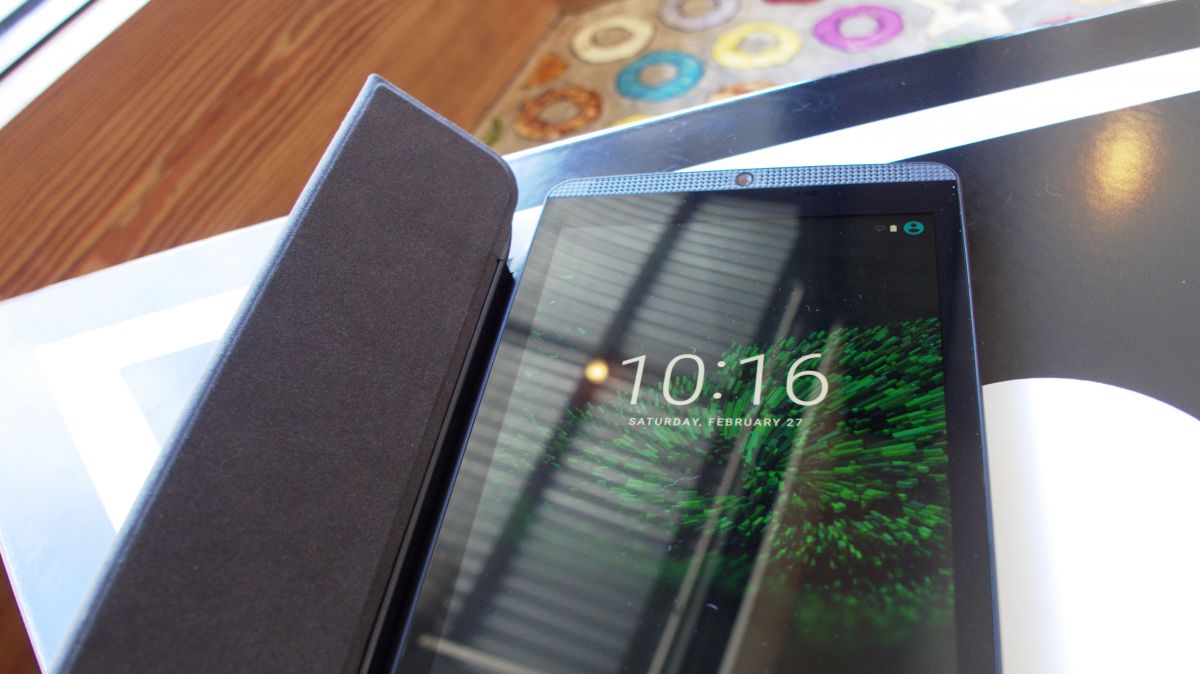
Nvidia’s latest iteration of the Shield Tablet is one of the few Android devices to adopt the latest operating system and it, more or less, feels like a stock Android experience. I expect it to jump onboard the Android 7, or “N”, ship whenever that comes around with good results.
Best of all, the K1 is cheaper than the last iteration of the Shield Tablet and is more powerful than ever. At $199 (£149, about AU$261,) the Nvidia Shield Tablet K1 is the tablet to buy if you’re looking for the near-perfect balance of value, power, features and looks.
Design
The backside of the Shield Tablet K1 is coated in an anti-slip surface, which does its job just fine, but easily collects fingerprints in the process. Sharing the matte-textured back is the rear 5MP camera and the shiny “Shield” logo embossed in the center.
On the front of the tablet we have a front-facing 5MP camera and two front-facing speakers. While the speakers are not going to blow away dedicated Bluetooth speakers, like the JBL Charge 2 or UE Boom 2, they sound excellent for being such a small tablet. In addition to the speakers, the Shield Tablet has a 3.5mm headphone jack up at the top for private listening.
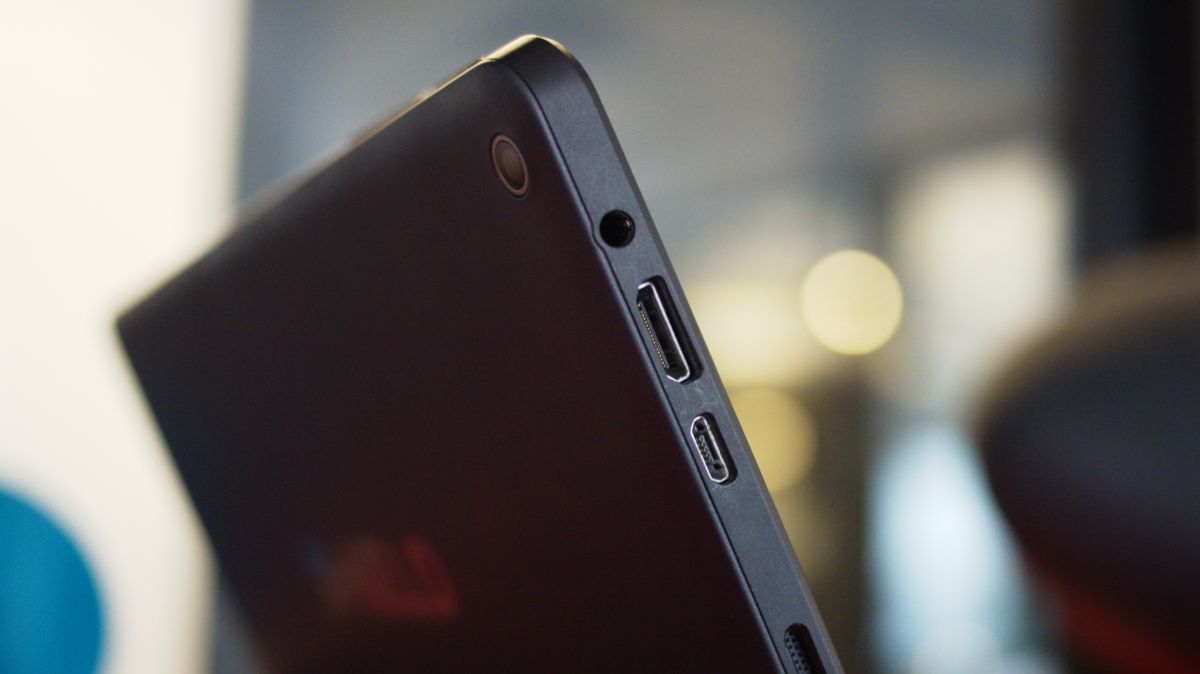
All of the Shield Tablet K1’s ports are located on its top, with its buttons running along the upper right hand side. And as this tablet lacks any physical face buttons, it can be tricky at times to tell which way you should grab it to power it on or adjust the volume. I found that the front-facing camera is a good point of reference.
The ports include micro USB, mini HDMI out, and a microSD card slot capable of taking up to 128GB cards. The Shield Tablet K1 offers a volume rocker and a power button, which are a little difficult to find and press without looking, unless you’re totally acclimated with the layout.
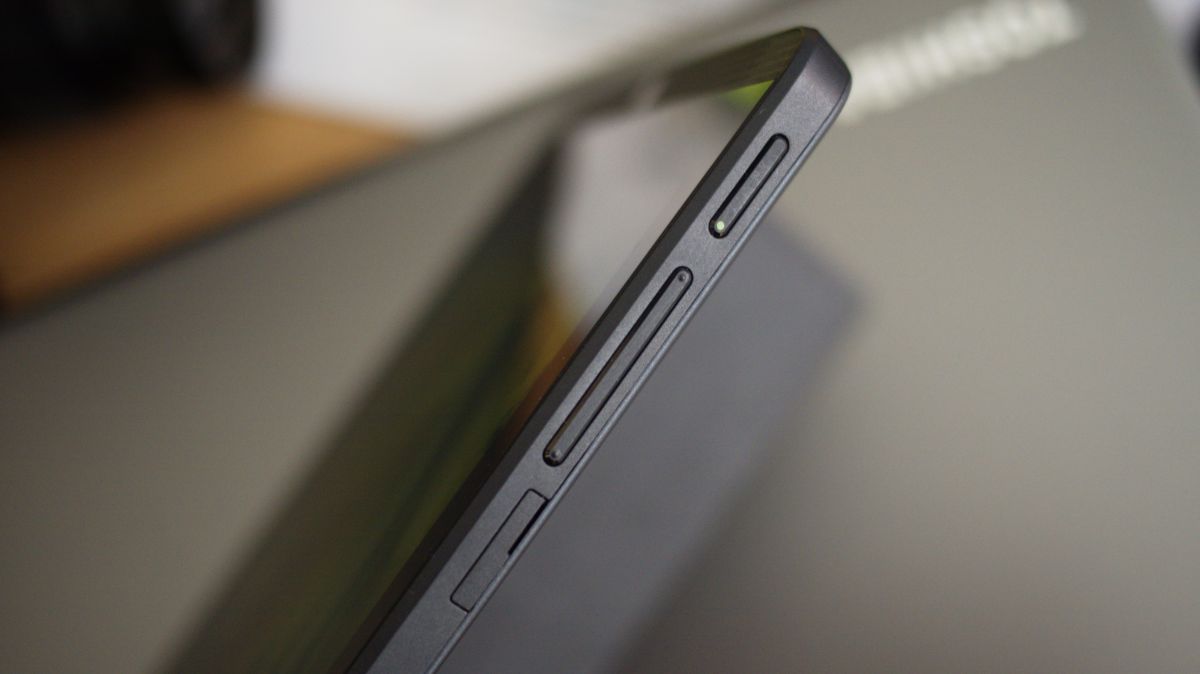
A subtle, but noticeable difference in the K1 is the rubberized speaker grilles. Not too sure what Nvidia’s thinking was in doing this, but it’s not a bad move. That said, they do attract a ton of fuzz. Also, extending from the speaker grilles, Nvidia has ditched the shiny, slanted plastic edge.
Performance, apps and battery life
The older iteration of the Shield Tablet came with Android KitKat, but Nvidia has now pushed out Android 5.1 to users, which brings the tablet right up to date and includes a new-look interface inspired by Google’s Material Design, as well as various performance improvements and fixes.
When the Shield Tablet K1 shipped, it now features Android 5.1 Lollipop out of the box. But now, users can look forward to over-the-air (OTA) access to Google’s sweetest mobile operating system, Android 6.0 Marshmallow. We were able to upgrade recently with no issue.
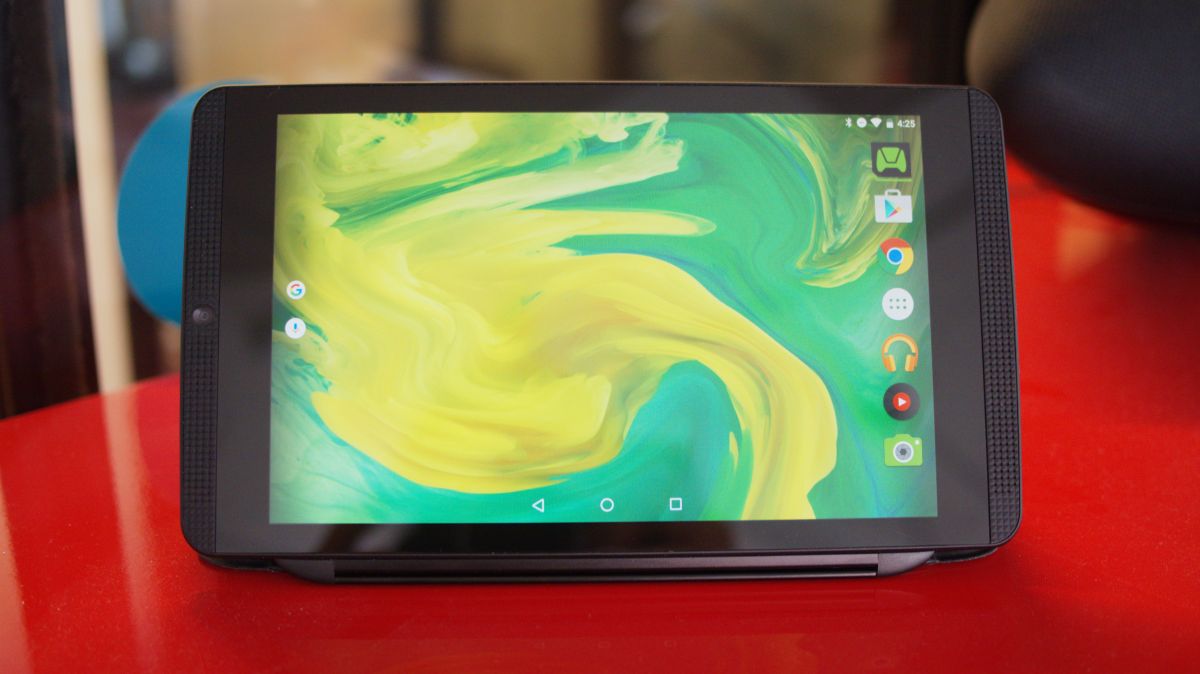
As I touched on, Google’s influence is clear in the fact that the Shield Tablet K1 feels like a stock version of Android, with the biggest difference being that Nvidia has pre-loaded the tablet with its Dabbler photo editing app and Shield Hub, a standalone experience for you to purchase, download, and launch your games with.
Arguably, the real star of the tablet is Nvidia’s Tegra K1 mobile superchip. The 2.2GHz quad-core ARM Cortex A15 SOC features Nvidia’s Kepler GPU architecture and 192 CUDA cores along with 2GB of low power DDR3 RAM. K1 supports many of the graphical features commonplace in GeForce graphics card including tessellation, HDR lighting, Global illumination, subsurface scattering, and more.

In our performance benchmarks, the K1 killed it and even beats out some more expensive smartphones and tablets in the process. Up until now, the original Shield’s actively-cooled Tegra 4 was one of the more powerful Android SOC on the market, but the Tegra K1 slaughters it across the board. In Antutu and GeekBench benchmark, we saw modest gains of 12% to 23% in Shield versus Shield Tablet action.
In GeekBench 3, the Nvidia Shield Tablet K1 scored a modest 1147 on the single-core benchmark, which puts it slightly below the Samsung Galaxy S6, but above both the Nexus 6 and OnePlus 2. For the multi-core score, it put up 3451, which powers over the much more expensive Nexus 9 and the devices listed above.
But in Passmark and GFX Bench’s Trex test, we saw nearly a 50% spread, and in 3DMark’s mobile Icestorm Unlimited test, we saw an astounding 90% advantage for the Shield Tablet. This is incredible when you consider that the tablet has no fans and a two-watt TDP. Compared to the second-gen Nexus 7, the Shield Tablet benchmarks anywhere from 77% to 250% faster. This SOC is smoking fast, even standing up well to newer devices like the Nexus 9.
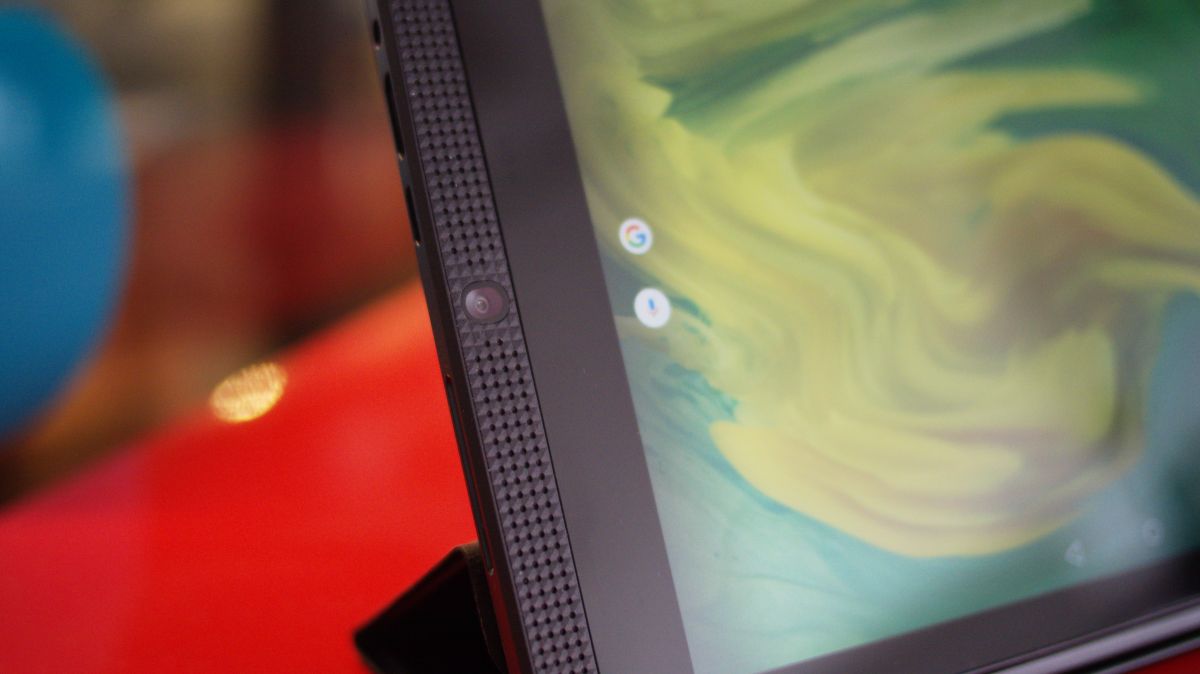
In terms of battery life, Nvidia is claiming you’ll get 10 hours watching/surfing the web and about five hours from gaming with its 19.75 Wh battery. This is up 3.75 Wh up from Google’s Nexus 7 equivalent and from our experiential tests, we found those figures to be fairly accurate if not a best case scenario. It will pretty much last you all day, but you’ll still want to let it sip juice every night.
Shield Controller
Of course if you’re going to game with it, you’re going to need Nvidia’s new wireless Shield Controller. Sold separately for $59.99/£49.99 (about AU$63), the 11.2-ounce Shield Controller maintains the same button layout as the original Shield controller, but feels a lot lighter and more comfortable to hold. While most Android game controllers operate over Bluetooth, Nvidia opted to go with Wi-Fi Direct stating that it offers 2x faster response time and more bandwidth.

The extra bandwidth allows you to plug in a 3.5mm headphone into the controller and also allows you to link up to four controllers to the device, which is an appreciated feature when you hook up the tablet to your HDTV via the Shield Tablet’s Console Mode. Other unique features of the controller include capacitive touch buttons for Android’s home, back, and play buttons.
There’s also a big green Nvidia button that launches Shield Hub. The controller also has a small triangle shaped clickable touch pad which allows you to navigate your tablet from afar. A quibble we had with it is that we wish the trackpad was more square, to at least mimic the dimensions of the tablet as the triangle shape was a little awkward to interface with.
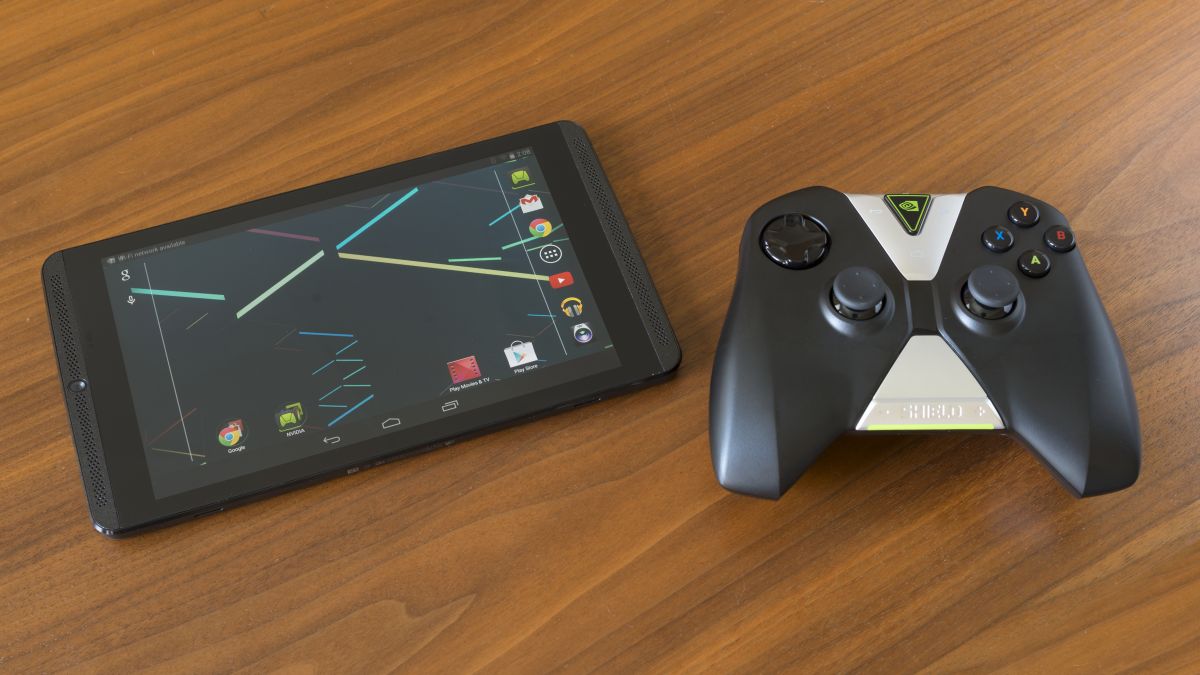
Another problem that we initially had with the controller was that the + volume button stopped working after a while. We contacted Nvidia about this and the company sent us a new unit which did remedy the issue, however. One noticeable missing feature from the controller is rumble support. Nvidia said this was omitted on the original Shield to keep the weight down, however its omission is a little more glaring this time around since there is no screen attached to the device.
Extras
The controller isn’t the only accessory that you’ll need to purchase separately if you want to tap into the full Shield Tablet experience, however. To effectively game with the tablet, you’ll need the Shield Tablet cover which also acts as a stand. Like most tablets, a magnet in the cover shuts off the Shield Tablet when closed but setting up the cover and getting it to stand-up is initially pretty confusing.
At the time of writing, the cover comes in black and looks rather fetching, like the iPad Smart Cover. Nice as it is, it’s a costly accessory at $39 (£19, about AU$51). It would really sweeten the deal if Nvidia decided to include the cover with the purchase of the Shield Tablet K1.

The Nvidia Shield Tablet K1 is considerably cheaper than before, and as a result, the overall offering inside of the box is more skimpy.
Gone from the package is a micro USB cable and power brick, which could be a bit problematic for some. Like the New Nintendo 3DS, you’ll need to provide your own. This exclusion from the bundle most definitely allowed for a cheaper price, but whether that ends up being good for you in the long run will depend on what your current stock of USB peripherals looks like.
Now, you’ll have to pony up $29 (£17, about AU$39) for the world charger set. To the benefit of frequent travelers, you’ll now have swappable plugs that work around the world.
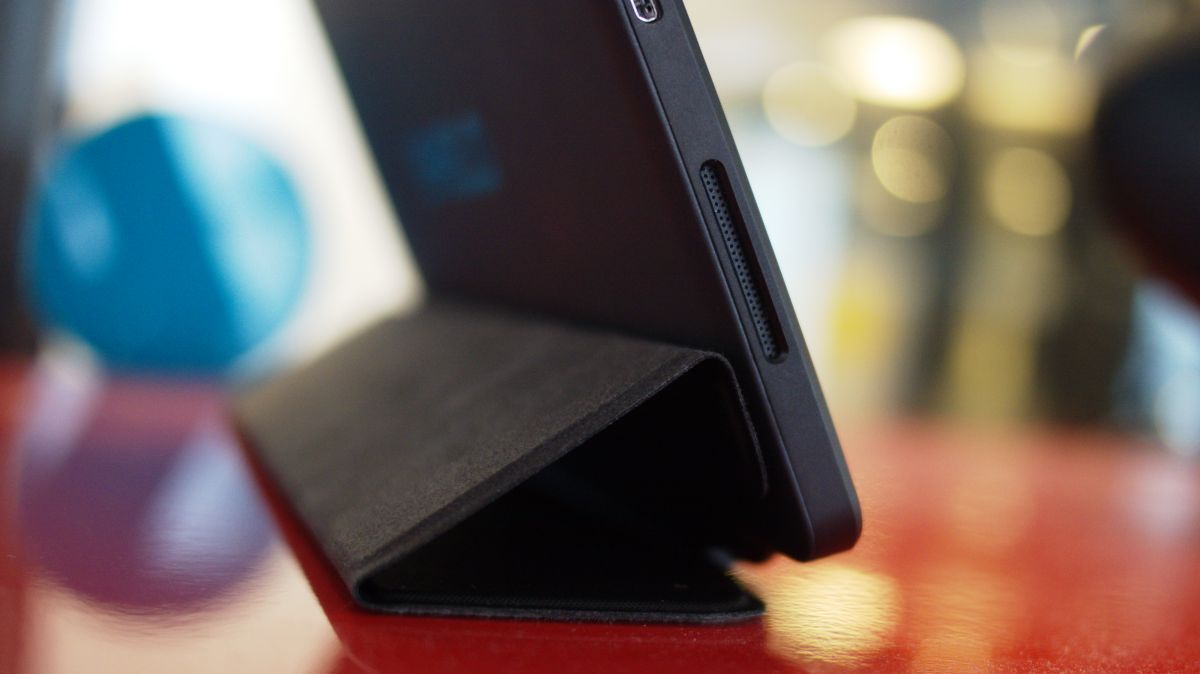
Also gone from the previous iteration of the Shield Tablet is the stylus. Nvidia Dabbler, the painting and photo editing software still comes standard with the K1, but you’ll have to use your finger or a third-party stylus instead, which is not a big deal. I’m really happy that Nvidia dashed the price of the Shield Tablet and if the exclusion of a stylus played any part in that, I’m glad to see it go.
Game features
But a stylus probably wasn’t why you were interested in a Shield Tablet in the first place. This device is a gaming tablet, first and foremost.
With gaming as the primary driver for Shield Tablet customers, you may wonder why Nvidia didn’t bundle its new controller. The company likely learned from Microsoft’s mistake with Kinect and the Xbox One: Gamers don’t like to spend money and getting the price as low as possible was likely on Nvidia’s mind. Of course, not everyone may even want a controller with the general lack of support for it in games. Nvidia says there are now around 400 Android titles that support its controller, but that’s only a small percentage of Android games and the straight truth is that the overwhelming majority of these games are garbage.
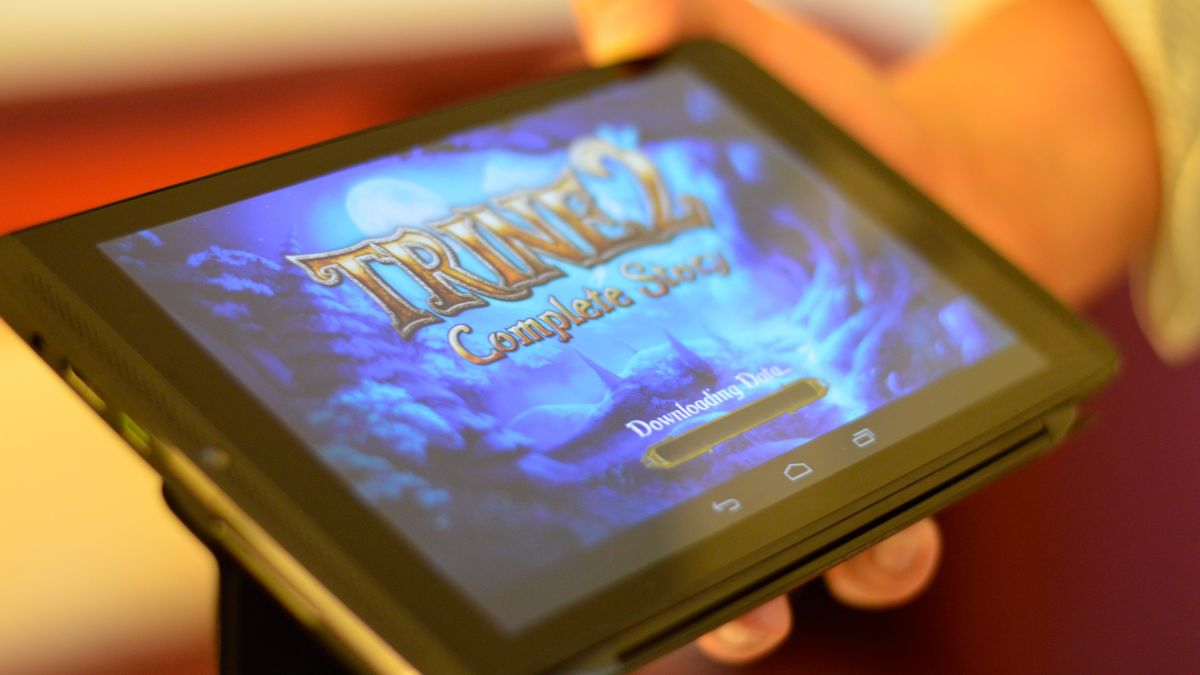
Nvidia is making a push for Android gaming, however. The company worked with Valve to port over Half Life 2 and Portal to the Shield and they look surprisingly fantastic and are easily the two prettiest games on Android at the moment. Whether Android will ever become a legitimate platform for hardcore gaming is anyone’s guess, but at least the Shield Tablet will net you a great front seat if the time ever arises.
Luckily you won’t have to rely solely on the Google Play store to get your gaming fix. Emulators run just as well here as they did on the original Shield and this iteration of Shield is also compatible with Gamestream, which is Nvidia’s streaming technology that allows you to stream games from your PC to your Shield. Gamestream, in theory, lets you play your controller-enabled PC games on a Shield.

At this point, Nvidia says Gamestream supports more than 100 games such as Batman: Arkham Origins and Titanfall from EA’s Origin and Valve’s Steam service. The problem though is there are hundreds more games on Steam and Origin that support controllers but not the Shield Tablet’s controller. For example, Final Fantasy VII, a game which we couldn’t get working with the original Shield still isn’t supported even though it works with an Xbox controller on the PC. When Gamestream does work, however, it’s relatively lag-free and kind of wonderful. The one caveat here is that you’ll have to get a 5GHz dual-band router to effectively get it working.
Verdict
Would we buy the Shield Tablet if we owned the original Shield (now renamed the Shield Portable)? Probably not. If we were looking for a new tablet and top notch gaming performance was on the checklist, the Shield Tablet K1 is easily the top contender today.
We’d take it over the second-gen Nexus 7 in a heart beat and even consider it over the iPad mini 3. While we understand why Nvidia decided to separate the cover and controller to keep the prices down and avoid the Kinect factor, we think a bundled package with a small price break as an alternative would have been nice. All things considered though, consider us surprised. The Shield Tablet K1 is pretty dang cool.
Source: techradar.com





































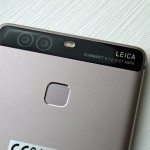




It will, if it runs Stream and has Bluetooth, well…….
Question, to make sure: is the full Google Play store available on this? I know that on some tablets it isn't. If it's possible, I'm sold.
Well that's an interesting question. I have the tablet and it does heat up a bit. The most heat i felt was during the directstylus app. after a couple hours of scribbling it got pretty hot. Under gaming (android) it heated up also but not as much you could say that felt normal and under the stream pc game function it didn't heat up much at all. Id say it does a good job to cool itself down. Tip: for the best Pc stream experience u have to get an otg usb cable to ethernet. that makes the streaming go from 720 on wifi to 1080 with the ethernet and is considerably smoother.
H5 =D
It gets warm, especially with games like Moden Combat 5 and Nova 3.
Up to 128gb cards supported… Yep, right, just fine for installing games. Was it not that, like with the note 7, nvdia presumably goes along with google approach, preventing users from moving apps to the sd card. Hopefully, they will have at least avoided the usb port charging issue which plagued the note 7..
So much for Charlie Demerjian's prediction that the Tegra K1 was gonna require a huge heatsink and require 50 odd watts, lol.
It will work with a USB controller, keyboard/mouse or hard drive with an otg cable. It will work with some Bluetooth controllers as well. But haven't found onebfoir my note 7 yet.
Yeah, I've seen the news. Personally I'd still be more inclined to go for the shield tablet because of its added gamestream capabilities (hardcore nvidia pc gamer here), but I can't see anything wrong with the nexus 9.
Personally I'd still be more inclined to go for the shield tablet because of its added gamestream capabilities (hardcore nvidia pc gamer here), but I can't see anything wrong with the nexus 9.
Samsung's ability to update their products is just pathetic, their Samsung Tab 3 is still at 4.2.2, Tab S is being updated to 5.02 before the Tab Pro which is still at 4.4.2, etc. if it wasn't for CyanogenMod releasing their ROMs for every Samsung tablet that is released I wouldn't touch their Android devices. With CM though, Samsung tablets are pretty decent, actually really good. The Nvidia Shield is a terrific tablet though, probably my favorite on the market right now. Love the HDMI out and I'm actually dumbfounded as to why no one else follows suit. Miracast is good but not quite fast enough for gaming, yet.
It was Nexus 9 (not 8) and yes, they did put a Tegra K1 chip on it
H5, same here bro.
I bought the nexus 7 back when that was the latest thing, and for the price it was a pretty amazing tablet. But now that you can get this with THE most powerful mobile chip we've seen so far for the same price I wish I had done what you did.
I've been looking at a few of the benchmarks people have been releasing over the last few days, and I have to say even though you would expect a tegra to score below expectations it's blowing everything else clean out the water. Already preordered mine now ready for the 14th. Can't wait!
I wonder what chip the Nexus 8 will use. If the new Google tablet doesn't stack up well against this i'll probably choose the shield.
The Shield has a memorycard slot. And we know Google is not going to put one on the Nexus 9, just like the 7 and 10. That is why I am going with the shield as soon as they get the cracked corners solved.
I gotta say — I have been holding back for a powerful tablet at the right price point.. this is definitely it. That Tegra K1 is a killer.
which works surprisingly well. there is also a way to configure the Shield Portable for complete remote control of your gaming PC, and from *outside* your home network! This means with a good 4G hotspot or wifi connection, a folding keyboard, BT mouse and a monitor, and you've got a BYOD suitable for actually doing work.
Haven't tried this across a secure tunnel yet, as I don't have that much hardware at home.
But I can access my home PC and run apps other than games from here at work.
I apologise if this makes me sound like a complete condescending douche, that isn't my intention here.
You do realise the tablet and controller are being sold separately? I believe the tablet is going to be £229/$299 and the controller is an additional £49.99/$59.99, should you want one.
Isn't this site more UK centric? Why the heck are you talking about weight in ounces? Are you trying to review steak?
Got mine free as nucklehead left it in used car and he gave us phoney phone number so we couldn't call him to let him know he left his tablet. Two weeks later he never showed. So…yeah, I like this over my 2013 Nexus 7 for all the obvious reasons, bigger and faster. Ordered a cover and screen protector too. Updated to the latest software too. I am not a gamer, much. But will load a few later on. Right now just handy as email and web grabber. Am not using the LTE version, just Wifi and it is faster, much faster than the Nexus 7. The 7 is still very, very good and I will give it to someone soon….
does it heat up noticeably during heavy gaming?
It is — the it is a fully functioning stock android tablet with some Nvidia additions. All Google apps and the full Play Store are available — which is why I pre-ordered this baby and all it's peripherals!
Nothing so far, only rumours. Although it looks as if they are implementing a single thumbstick now on the left hand side. First the touch screen, now this. Looking less and less like I'll be getting one personally. I'll wait and see what the general consensus is once it's been officially released.
This is a feature, it was added a while ago on the Shield portable. You can stream Steam titles to the device, assuming that your computer has a GTX card in it.
My note 7, went from android 4.1 to 4.4.2 in only 3 months with 4.2 and 4.3 along the way! And nvidia support full android systems, play store, etc. Not interested in Nexus devices due to no memory expansion, full otg functions and hdmi out. I'm quite sold on stock android now, something Samsung are severely lacking with updates on their products(my s4 mini is still on 4.2. Tegra note 7 is fab, can't wait to see shield tablet